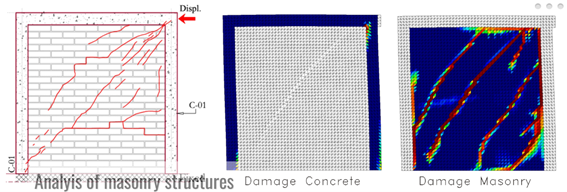PLCd (PLastic Crack dynamic) is a finite element code designed for the numerical simulation of nonlinear dynamic behaviour in complex structural systems. It has been developed at the International Centre for Numerical Methods in Engineering (CIMNE) and the Department of Structures and Strength of Materials at the Technical University of Catalonia (UPC).


Example Applications of PLCd
Analysis of Masonry Structures
The first set of images illustrates the application of PLCd to the simulation of masonry wall behaviour under lateral displacement.
-
- The left figure shows the crack pattern and displacement evolution.
- The centre figure represents the progressive damage in the surrounding concrete frame.
- The right figure highlights the damage distribution in the masonry infill, where diagonal cracking and failure mechanisms can be clearly identified.
Composite Materials – Failure Analysis
The second set of images demonstrates the use of PLCd in the study of failure in composite laminates with mechanical fasteners.
-
- The numerical simulation (left) captures the initiation and propagation of cracks around the holes, showing the zones of maximum damage concentration.
- The experimental image (right) presents the corresponding physical test, confirming the fracture pattern predicted by the numerical model.
About PLCd
PLCd (PLastic Crack dynamic) is an implicitly formulated finite element code for the numerical simulation of nonlinear dynamic behaviour in structurally complex systems. It is jointly developed at the International Centre for Numerical Methods in Engineering (CIMNE) and the Department of Structures and Strength of Materials at the Technical University of Catalonia (UPC).
PLCd is an academic software package. Its initial version was released in 1989 and it has been under continuous development ever since, with enhancements driven by ongoing research.
The developers behind the code include:
Sergio Oller Martínez, Bibiana María Luccioni, Omar Salomón, Alexandru Hanganu, Eduardo J. Car, Laurentiu Neamtu, Fernando Zalamea, Fernando Rastellini, Liz Gabriela Nallim, Pablo Mata Almonacid, Xavier Martínez, Maritzabel Molina Herrera, Jairo A. Paredes, Cuauhtémoc Escudero Torres, Facundo J. Bellomo, Ricardo Daniel Quinteros, Fermín Otero Gruer, Ester Comellas Sanfeliu, Lucia Grăţiela Barbu, Stefano Zaghi, Alejandro Cornejo, and Sergio Jiménez.
In 1993, PLCd was honoured with an Argentinian award presented by IBM in the fields of Exact Sciences, Engineering, Physics, Astronomy and Mathematics. The recognition was in appreciation of its application to the “Numerical Simulation of Structures Made with Frictional Materials”, and the award was accepted by Professors Oller and Luccioni.
Main Features and Capabilities
-
- Programming and Platforms: PLCd is implemented in FORTRAN and is fully parallelised. It is compatible with both Linux and Windows.
- Scope of Analysis: It targets solid mechanics problems—quasi-static, dynamic, or seismic—considering both material and geometric nonlinearities. Dynamic analyses utilise the Newmark time-integration scheme.
- Element Types:
- 3D solids: tetrahedral elements (4-node or 10-node) and hexahedral elements (8-node or 20-node).
- 2D solids: triangular (3-node or 6-node) and quadrilateral (4-node, 8-node or 9-node) elements.
- Beams: Timoshenko beam elements with 3 or 4 nodes, featuring numerical integration across the cross-section.
- Shells: based on the DKT-OPT formulation using implicit solver mode.
- Solver Options:
- Implicit Solver: As above.
- Explicit-Time-Step Solver: Includes advanced laminated shell elements—BST, LBST, EBST—which are rotation-free. Curvatures are approximated by utilising a patch of neighbouring elements, following formulations introduced by Eugenio Oñate, Francisco Zárate, and Fernando Flores.
- Material Models: Supports large-strain elasticity (Neo-Hookean, Mooney–Rivlin, Yeoh, Ogden, etc.), viscoelasticity, diverse damage models, and non-associated plasticity with isotropic and kinematic hardening—where isotropic hardening may be positive, negative, or null. Tangent stiffness tensors may be derived analytically or numerically.
- Yield Criteria: Implements six yield functions: Tresca, von Mises, Mohr-Coulomb (standard and generalised), Drucker-Prager, Lubliner-Oller, and a damage-based criterion on the norm of principal stresses. General anisotropy is accommodated via a mapping-based formulation.
- Composite Materials: Offers both phenomenological homogenisation (using classical mixing and serial/parallel theories) and computationally efficient two-scale numerical homogenisation, enabling nonlinear behaviour of composite constituents to be faithfully represented.
- Fatigue Analysis: Provides dedicated formulations for High-Cycle Fatigue (HCF), Low-Cycle Fatigue (LCF), and Ultra-Low-Cycle Fatigue (ULCF) applicable to metals and composite materials.
Download
PLCd is an academic software package and is intended for academic and research purposes only.
The code is distributed in two different formats: as a GiD ProblemType and as standalone executables (with ASCII input data). Both formats can be downloaded through the following links:
-
- PLCd as a GiD ProblemType
- PLCd IMPLICIT executable
- PLCd EXPLICIT executable v79.11.3 (Linux, version in use, employed for seismic analysis)
- PLCd EXPLICIT executable v79.11.6 (Linux, last version, employed for seismic analysis)
Although the PLCd development team does not provide formal technical support, inquiries, comments, requests, and bug reports may be sent by email to: plcd@cimne.upc.edu We will make every effort to assist you with the use of the code.






